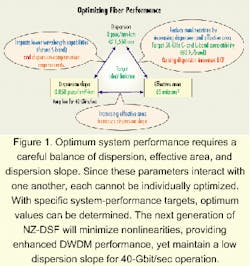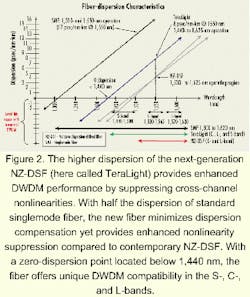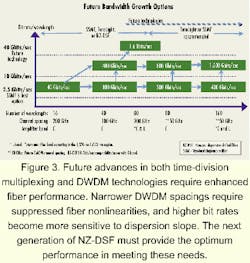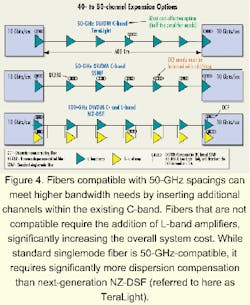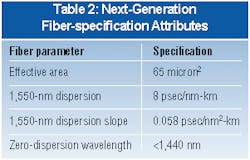Next-generation NZ-DSF fibers will balance performance characteristics
Jim Ryan Alcatel Cable Networks
Technology evolution to ward higher bit rates, closer DWDM channel spacings, and more amplifier bands continues to push the capabilities of the fibers used in long-distance networks. By optimizing effective area, dispersion, and dispersion slope, optical fiber can be made to better accommodate this bandwidth growth. To meet tomorrow's needs, fiber must have optimum performance in the C- and L-amplifier bands for both 10-Gbit/sec systems with 50-GHz channel spacings and future 40-Gbit/sec DWDM applications.The move toward high bit rates and closer channel spacings has resulted in the obsolescence of numerous generations of dispersion-shifted fiber (DSF) and nonzero dispersion-shifted fiber (NZ-DSF). Higher degrees of obsolescence protection are possible by anticipating future system trends and optimizing fiber performance in advance. Compatibility with future amplifier regions such as the S-band is also needed.
By careful consideration of system limiting parameters (see Table 1), key fiber attributes can be balanced to achieve optimum system performance in the next generation of NZ-DSF. Since system limitations vary with different technologies, such as higher bit rates, closer channel spacings, and extended bands, careful consideration must be given to future systems, because:
- Closer channel spacings become significantly more sensitive to cross channel nonlinearities.
- Higher bit rates become more sensitive to dispersion, dispersion slope, PMD, signal/noise, and non-linearities.
- New amplifier bands require fiber compatibility.
Unfortunately, all system limitations cannot be simultaneously minimized in optical fibers. Dispersion, dispersion slope, effective area, and nonlinearities are all interrelated and must be balanced to achieve optimum system performance. Examples of these interactions are shown in Figure 1 and are described in more detail here:
- Dispersion and effective area: Cross-channel nonlinearities can be reduced by increasing the dispersion and effective area. Unfortunately increases in these parameters must be balanced by their impacts with other parameters.
- Dispersion and cross-channel nonlinearities (FWM and XPM): Increasing dispersion reduces cross-channel nonlinearities but requires more dispersion compensation in long-distance high-bit-rate applications (10 and 40 Gbits/sec). To achieve an ideal balance, dispersion must be high enough to minimize nonlinearity effects, but it should not be higher than needed to keep dispersion compensation to a minimum.
- Effective area and dispersion slope: Increasing the effective area reduces the cross-channel nonlinearities; however, this also increases the dispersion slope and a fiber's sensitivity to micro and macro bending losses. Since a low dispersion slope becomes important in 40-Gbit/sec system applications, an ideal balance of effective area and dispersion slope must be achieved. The zero dispersion slope and 1,550-nm dispersion choices also affect the DWDM performance in the lower wavelength region. Careful optimization can also provide compatibility with the future S-band (1,440 to 1,500 nm).
As Figure 1 shows, careful consideration must be given to obtain the ideal balance of dispersion, effective area, and dispersion slope to achieve optimum system performance in high-bit-rate, narrow-channel-spacing applications. The parameters shown in Table 2 provide this ideal mix. The resulting next-generation NZ-DSF with optimized-dispersion fiber provides optimum performance with both current and future system needs.
Since the dispersion and nonlinearity relationship is not linear, an optimum value can be chosen that significantly suppresses cross-channel nonlinearities. The 8-psec/nm-km dispersion set point provides half the dispersion of standard singlemode fiber (SSMF) yet is high enough to provide good nonlinearity suppression. This significantly reduces the compensation needs compared to singlemode fiber for 10- and 40-Gbit/sec applications. Choosing lower dispersion operating points negatively affects both the non-linearity performance and close channel-spacing capabilities such as 50-GHz DWDM with 10-Gbit/sec systems.
With a 65-micron2 effective area, the next-generation NZ-DSF obtains the benefits of a larger effective area to suppress nonlinearities, without sacrificing the dispersion-slope performance needed for 40-Gbit/sec transmission. Choosing higher effective-area values would negatively impact the dispersion slope, adversely affecting 40-Gbit/sec performance. A low dispersion slope minimizes the dispersion differences between wavelengths within an amplifier band and also reduces the differences between amplifier bands. This makes dispersion management at different wavelengths on 40-Gbit/sec systems more manageable.
By suppressing cross-channel non-linearities, the combined effects of dispersion and effective area provide narrow channel-spacing capabilities in both the C-band (1,530 to 1,565 nm) and L-band (1,570 to 1,620 nm). The fiber supports 50-GHz DWDM channel spacings for 10-Gbit/sec systems in both the C- and L-bands, even with power/channel levels as high as 5 dBm without forward error correction (FEC). This characteristic permits 80-channel systems to be designed to the same amplifier spacings as 40-channel systems. Carriers can therefore grow their bandwidth without sacrificing span distances or requiring the use of L-band amplifiers.
In contrast, current NZ-DSF fibers require careful consideration when deploying 50-GHz spacings in the C-band. Lower power/channel levels and possibly FEC system techniques may be required. To accommodate higher channel needs, current NZ-DSF fibers require closer amplifier spacings or the use of L-band amplifiers above 40 channels.With 40-Gbit/sec applications, 100% of the fiber is typically dispersion compensated. This compensation combined with a fiber's dispersion and dispersion slope results in an end-to-end dispersion slope that can be system limiting. Next-generation NZ-DSF must optimize the dispersion and dispersion slope to provide enhanced end-to-end performance with DCF.
Higher bandwidth needs may be met by increasing the system bit rate and/or increasing the DWDM channel count. Using closer channel spacings or expanding into additional amplifier band regions can increase the DWDM channel capabilities. Figure 3 shows examples of different methods of meeting bandwidth growth needs. The method of bandwidth growth will significantly affect cost and is sensitive to the fiber type deployed. As indicated earlier, current NZ-DSF fibers have limitations in upgrading beyond 40 channels with 50-GHz channel spacings in the C-band.While SSMF is also 50-GHz compatible, it requires substantially more dispersion compensation compared to the next-generation NZ-DSF fiber with an optimizing dispersion. As Figure 4 shows, compensation can be required at most, if not every amplifier point on long SSMF routes. This interferes with the ability to implement optical add/drop capabilities.
With 50-GHz capabilities in both the C- and L-band, the next-generation NZ-DSF offers a capacity of greater than 160 channels of 10 Gbits/sec for a data capacity of >1.6 Tbits/sec. This capacity can be further expanded by also incorporating the capacity of the S-band. Current NZ-DSF fibers are typically limited to 120 channels -40 in the C-band, and 80 in the L-band. In addition, current NZ-DSF fibers cannot take advantage of additional growth in the S-band due to the location of their zero-dispersion region. For cost-effective bandwidth growth, the deployment scheme in Table 3 is recommended.
A next-generation NZ-DSF based with an optimized dispersion (recently unveiled under the "Teralight" brand) meets both today's and future system needs. By optimizing dispersion, effective area, and dispersion slope, cross-channel nonlinearities have been suppressed to provide optimum high-channel, high-data-rate system performance. The fiber provides growth capabilities with either 40-Gbit/sec systems or increased 10-Gbit/sec-channel deployment with 50-GHz DWDM.The next-generation fiber offers greater than 160 channels of capacity in the C- and L-bands at 10 Gbits/sec for greater than 1.6 Tbits/sec of bandwidth capacity. Even further capacity is available by taking advantage of the S-band compatibility in the 1,440- to 1,550-nm range. Significant savings are achieved in deploying this capacity through eliminating or deferring the L-band amplifiers. L-band amplifiers are not required until the capacity extends beyond 80 channels.
By properly balancing key fiber parameters, next-generation NZ-DSF with optimized dispersion properties offers flexibility in meeting future long-distance growth requirements through a combination of enhanced DWDM deployment and/or higher bit rates such as 40 Gbits/sec.
Jim Ryan is the new-business-development marketing manager for Alcatel Cable Network Products (Claremont, NC). He can be reached at [email protected].
